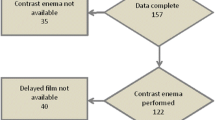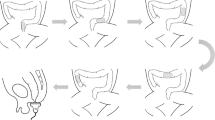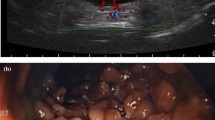Abstract
Background
Various patterns of colonic mucosal irregularity have been recorded on contrast enema, each with individually very low sensitivity, but high specificity.
Objective
To assess the accuracy of the radiologic features of Hirschsprung disease utilising a unifying stratification of any form of colonic mucosal irregularity on contrast enema.
Materials and methods
We conducted a retrospective study of children with suspected Hirschsprung disease managed at a tertiary South African hospital from January 2009 through April 2015. Three observers independently reviewed abdominal radiographs and contrast enemas. The enema analysis included a unifying category of any form of colonic mucosal irregularity. Radiologic features were compared with rectal biopsy results. We used descriptive statistics and the Fisher exact test to compare the radiologic features of children with and without Hirschsprung disease.
Results
Ninety-two children with median age of 37 days (range 3 days to 11 years) were included; 50 had biopsy-proven Hirschsprung disease. On enema, any mucosal irregularity, a transition zone and recto-sigmoid ratio inversion were associated with Hirschsprung disease (all P<0.01). Mucosal irregularity showed 96% sensitivity (95% confidence interval [CI] 86.3–99.5) and 71.4% specificity (CI 55.4–84.3); a transition zone showed 86% sensitivity (CI 73.3–94.2) and 90.5% specificity (CI 77.4–97.3); and recto-sigmoid ratio inversion showed 78% sensitivity (CI 64.0–88.5) and 83.3% specificity (CI 68.3–93.0).
Conclusion
Colonic mucosal irregularity on contrast enema has high sensitivity and moderate specificity for Hirschsprung disease.




Similar content being viewed by others
References
McDonald RG, Evans WA (1954) Hirschsprung’s disease; roentgen diagnosis in infants. AMA Am J Dis Child 87:575–585
Kosloske AM, Goldthorn JF (1984) Early diagnosis and treatment of Hirschsprung’s disease in New Mexico. Surg Gynecol Obstet 158:233–237
Stensrud KJ, Emblem R, Bjørnland K (2012) Late diagnosis of Hirschsprung disease — patient characteristics and results. J Pediatr Surg 47:1874–1879
Berman CZ (1956) Roentgenographic manifestation of congenital megacolon (Hirschprung’s disease) in early infancy. Pediatrics 18:227–228
Hayakawa K, Hamanaka Y, Suzuki M et al (2003) Radiological findings in total colon aganglionosis and allied disorders. Radiat Med 21:128–134
Sheng TW, Wang CJ, Lo WC et al (2012) Total colonic aganglionosis: reappraisal of contrast enema study. J Radiol Sci 37:11–19
Basnet A, Zheng S (2006) Total colonic aganglionosis: diagnosis and treatment. World J Pediatr 2:97–101
Taxman TL, Yulish BS, Rothstein FC (1986) How useful is the barium enema in the diagnosis of infantile Hirschsprung’s disease? Am J Dis Child 140:881–884
Ouladsaiad M (2016) How to manage a late diagnosed Hirschsprung's disease. Afr J Paediatr Surg 13:82–87
Lewis NA, Levitt MA, Zallen GS et al (2003) Diagnosing Hirschsprung’s disease: increasing the odds of a positive rectal biopsy result. J Pediatr Surg 38:412–416
Alehossein M, Roohi A, Pourgholami M et al (2015) Diagnostic accuracy of radiologic scoring system for evaluation of suspicious Hirschsprung disease in children. Iran J Radiol 12:e12451
Peyvasteh M, Askarpour S, Ostadian N et al (2016) Diagnostic accuracy of barium enema findings in Hirschprung’s disease. Arq Bras Cir Dig 29:155–158
O’Donovan AN, Habra G, Somers S et al (1996) Diagnosis of Hirschsprung’s disease. AJR Am J Roentgenol 167:517–520
Meier-Ruge W, Lutterbeck PM, Herzog B et al (1972) Acetylcholinesterase activity in section biopsies of the rectum in the diagnosis of Hirschsprung’s disease. J Pediatr Surg 7:11–17
Swenson O, Neuhauser EB, Picklett LK (1949) New concepts of the etiology, diagnosis and treatment of congenital megacolon (Hirschprung's disease). Pediatrics 4:201–209
Hope JW, Borns PF, Berg PK (1965) Roentgenologic manifestations of Hirschprung's disease in infancy. Am J Roengenol Radium Ther Nucl Med 95:217–229
Rosenfield NS, Ablow RC, Markowitz RI et al (1984) Hirschsprung’s disease: accuracy of the barium enema examination. Radiology 150:393–400
Smith GHH, Cass D (1991) Infantile Hirschsprung’s disease — is barium enema useful? Pediatric Surg Int 6:318–321
Marei MM, Abdelsattar AH, Yassin TM et al (2015) Reducing the frequency of unnecessary rectal biopsies by combined interpretation of clinical and radiological findings in Egyptian children with suspected Hirschsprung’s disease. Gaz Egypt Paediatr Assoc 63:80–85
Lockhart-Mummery HE, Morson BC (1964) Crohn’s disease of the large intestine. Gut 5:493–509
Snyder MJ (2004) Imaging of colonic diverticular disease. Clin Col Rect Surg 17:155–162
Lee CC, Lien R, Chian MC et al (2012) Clinical impacts of delayed diagnosis of Hirschsprung’s disease in newborn infants. J Pediatr Neonatol 53:133–137
De Haro JI, Palazón Bellver P, Julia Masip V et al (2016) Effectiveness of calretinin and role of age in the diagnosis of Hirschsprung disease. Pediatr Surg Int 32:723–727
Tabbers MM, DiLorenzo C, Berger MY et al (2014) Evaluation and treatment of functional constipation in infants and children: evidence-based recommendations from ESPGHAN and NASPGHAN. J Pediatr Gastroenterol Nutr 58:265–281
Proctor ML, Traubici J, Langer JC et al (2003) Correlation between radiographic transition zone and level of aganglionosis in Hirschsprung's disease: implications for surgical approach. J Pediatr Surg 38:775–778
Jamieson DH, Dundas SE, Belushi SA et al (2004) Does the transition zone reliably delineate aganglionic bowel in Hirschsprung's disease? Pediatr Radiol 34:811–815
Muller CO, Mignot C, Belarbi N et al (2012) Does the radiographic transition zone correlate with the level of aganglionosis on the specimen in Hirschsprung's disease? Pediatr Surg Int 28:597–601
Chen X, Xiaojuan W, Zhang H et al (2017) Diagnostic value of the preoperatively detected radiological transition zone in Hirschsprung's disease. Pediatr Surg Int 33:581–586
Moore SW, Maluleke T, El Hosny AA (2019) Is Hirschsprung disease a purely neurological condition? A study of the actin G2 smooth muscle gene in Hirschsprung disease. J Pediatr Surg 54:2028–2031
Budianto IR, Obata S, Kinoshita Y et al (2015) Reevaluation of acetylcholinesterase staining for the diagnosis of Hirschsprung disease and allied disorders. J Pediatr Gastroenterol Nutr 60:606–612
Acknowledgements
Special thanks to Prof. Martin Kidd from the Centre of Statistical Consultation, Department of Statistics and Actuarial Sciences, Stellenbosch University.
Author information
Authors and Affiliations
Corresponding author
Ethics declarations
Conflicts of interest
None
Additional information
Publisher’s note
Springer Nature remains neutral with regard to jurisdictional claims in published maps and institutional affiliations.
Electronic supplementary material
Rights and permissions
About this article
Cite this article
Vlok, S.S.C., Moore, S.W., Schubert, P.T. et al. Accuracy of colonic mucosal patterns at contrast enema for diagnosis of Hirschsprung disease. Pediatr Radiol 50, 810–816 (2020). https://doi.org/10.1007/s00247-020-04631-2
Received:
Revised:
Accepted:
Published:
Issue Date:
DOI: https://doi.org/10.1007/s00247-020-04631-2




